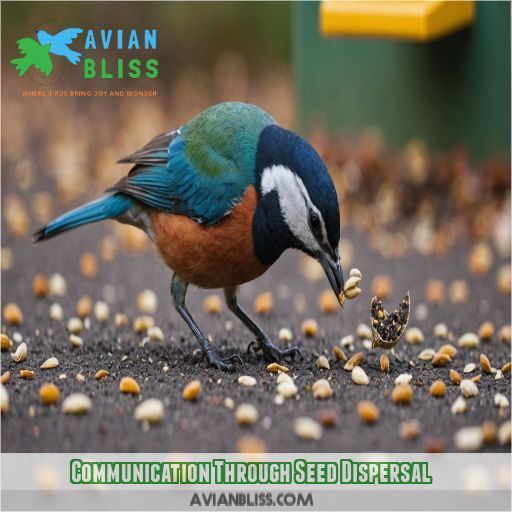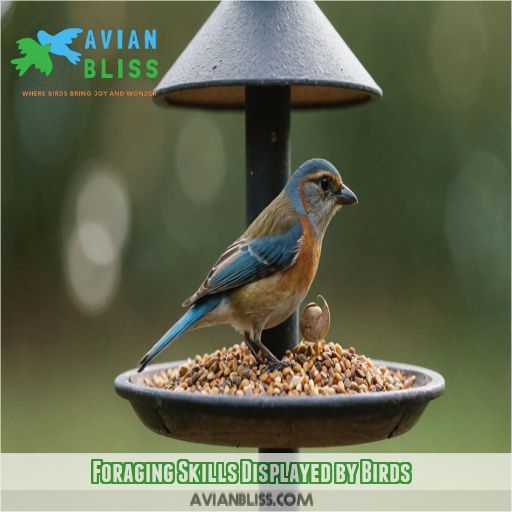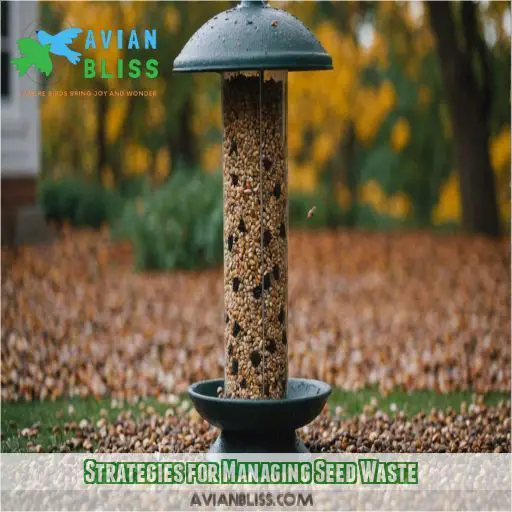This site is supported by our readers. We may earn a commission, at no cost to you, if you purchase through links.

Well, it’s not just because they’re picky eaters (although, they kind of are!).
Birds have a keen eye for quality seeds, and they’ll actively toss out the bad ones to get to the good stuff.
They’re looking for the most nutritious seeds to fuel their high-energy lifestyles.
By throwing out unwanted seeds, they’re also maintaining feeder etiquette and reducing competition.
It’s all about strategy and survival!
Want to know more about the fascinating world of bird behavior and how to optimize your feeder for minimal waste?
Table Of Contents
- Key Takeaways
- Bird Behavior and Seed Dispersal
- Why Birds Throw Seeds Out of Feeders
- Impact of Feeding Efficiency on Bird Behavior
- Choosing the Right Bird Seed Blend
- The Value of Quality Bird Seed
- Avoiding Common Bird Feeding Mistakes
- Communication Through Seed Dispersal
- Foraging Skills Displayed by Birds
- Strategies for Managing Seed Waste
- Frequently Asked Questions (FAQs)
- How do you stop birds from throwing seeds?
- Why does my bird throw his food out?
- Do birds recognize humans who feed them?
- Is it okay to throw bird seed on the ground?
- Do birds exhibit seed throwing behavior in the wild too?
- What are the differences in seed scattering among bird species?
- Can bird seed blends be tailored to minimize seed waste?
- How does bird feeder design affect seed throwing behavior?
- Are certain bird species more prone to seed scattering behavior?
- Conclusion
Key Takeaways
- You’re not just a bird enthusiast, you’re also a feeder referee! Birds throw seeds out of the feeder because they’re picky eaters, and they’re looking for the most nutritious seeds to fuel their high-energy lifestyles. By understanding their behavior, you can create a bird-friendly haven that meets their needs.
- It’s not just about the seeds, it’s about the strategy! Birds scatter seeds to mark their territory, reduce competition, and even aid in plant propagation. By recognizing these behaviors, you can optimize your feeder for minimal waste and maximum bird satisfaction.
- You get what you pay for, and cheap Seed Blends can be a real waste! By investing in high-quality seed blends that cater to the preferences of your backyard birds, you can reduce waste and create a more harmonious feeding environment. Look for blends with minimal waste ingredients and a higher cost per edible pound.
- Feeder Design matters, and it’s not just about looks! By choosing a feeder that allows birds to easily access seeds without spilling, you can reduce waste and make cleanup a breeze. Consider feeders with trays or enclosed spaces, and don’t be afraid to get creative with your feeder setup!
Bird Behavior and Seed Dispersal
You’re probably wondering why birds are so picky about the seeds in your feeder, tossing some out while devouring others. As it turns out, this seemingly wasteful behavior is rooted in their natural feeding instincts, social dynamics, and clever strategies for seed dispersal and plant propagation.
Natural Feeding Instincts of Birds
Birds have innate feeding instincts honed over millennia. From carefully selecting nutritious seeds to strategically caching food, their behaviors reflect an intricate understanding of their environment and nutritional needs. Observing these natural tendencies can provide valuable insights into the lives of our feathered friends.
- Birds are selective eaters, carefully choosing the most nutritious seeds and discarding less appealing ones.
- Many species, like chickadees and nuthatches, instinctively store food to make sure they’ve a steady supply during lean times.
- Nestling birds rely on their parents to provide a balanced diet, showcasing the complex feeding behaviors of avian families.
Seed Scattering as a Territorial Marking Strategy
You’re probably wondering why birds scatter seeds from your feeder. It’s not just a messy habit, but a clever territorial marking strategy. By scattering seeds, birds signal ownership, warning others to stay away from their turf.
| Bird Species | Seed Scattering Behavior | Territorial Marking Purpose |
|---|---|---|
| Blue Jays | Aggressive seed throwing | Establish dominance |
| Sparrows | Subtle seed scattering | Maintain social hierarchy |
| Finches | Selective seed tossing | Reduce competition |
| Cardinals | Strategic seed placement | Signal territorial boundaries |
| Chickadees | Caching seeds | Store food for later use |
Social Dynamics Around Feeders and Seed Sharing
As you watch birds at the feeder, you’re witnessing a complex social dance. Dominant birds throw seeds to assert dominance, while others scatter them to maintain feeder etiquette and avoid territorial disputes, all within the strict rules of bird hierarchies.
Seed Dispersal as a Strategy for Plant Propagation
As you watch birds scatter seeds, you’re witnessing a clever strategy for plant propagation. By dispersing seeds, birds facilitate forest regeneration and ecosystem health. It’s a win-win: birds get food, and plants get a helping hand in spreading their roots.
Why Birds Throw Seeds Out of Feeders
You’ve probably noticed that birds tend to throw seeds out of your feeder, and you’re wondering why they do this – is it just a messy eating habit or is there more to it?
As it turns out, birds throw seeds out of feeders for a variety of reasons.
- Caching food for later: Birds might be storing seeds for a rainy day.
- Removing unwanted seeds and shells: Birds might be getting rid of seeds they don’t like or shells that get in the way.
- Protecting against rancid food: Birds might be throwing out seeds that have gone bad to avoid getting sick.
- Creating spacing at crowded feeders: Birds might be trying to make room for themselves at a busy feeder. (Source)
Caching Food for Later Use
You’re probably wondering why birds throw seeds out of feeders. One reason is caching food for later use. Birds like chickadees, juncos, and nuthatches instinctively hide seeds to survive lean periods, showcasing impressive memory and hoarding behavior.
Here are 3 fascinating caching strategies:
- Stashing seeds in various spots: Birds scatter seeds in multiple locations to retrieve later, reducing competition and ensuring a steady food supply.
- Using visual cues: Birds use visual markers to remember where they cached seeds, showcasing impressive spatial memory.
- Caching seeds in clusters: Some birds store seeds in clusters, making it easier to retrieve them during winter when food is scarce.
Removing Unwanted Foods and Shells for Easy Digestion
As you watch birds toss seeds out of feeders, remember they’re not being picky, just practical. They remove unwanted seeds and shells to boost digestive efficiency and absorb maximum nutritional value – a clever strategy to get the most out of their meals.
Protecting Against Rancid Food and Maintaining Flock Health
When birds throw seeds out of feeders, they’re protecting themselves from rancid food and maintaining flock health. They instinctively detect mold and contamination, rejecting spoiled seeds to avoid illness. It’s like they’re saying, "Hey, this sunflower seed is past its expiration date!
Creating Spacing at Crowded Feeders and Reducing Competition
You’ve probably noticed birds throwing seeds out of your feeder, but did you know they’re actually creating spacing and reducing competition? By scattering seeds, dominant birds establish their territory and maintain social hierarchies, making feeder design and seed preferences important.
Impact of Feeding Efficiency on Bird Behavior
You’re probably wondering why birds throw seeds out of the feeder, and it turns out their behavior is closely tied to feeding efficiency. By understanding how seed wastage affects feeding dynamics and learning strategies to minimize spillage, you can create a more harmonious and efficient feeding environment for your feathered friends.
Effects of Seed Wastage on Feeding Dynamics
You’re probably wondering how seed wastage affects the feeding dynamics. Well, it’s a real game-changer! Seed scattering leads to food wastage, attracting unwanted rodents (Source), compromising feeder cleanliness , and altering bird behavior . This can disrupt feeding efficiency, create competition, and even impact bird health .
Strategies for Minimizing Seed Spillage and Waste
- Optimize your feeder design: Choose a feeder that allows birds to easily access seeds without spilling.
- Select the right seed types: Offer seeds that birds prefer, reducing the likelihood of them tossing unwanted seeds.
- Maintain good cleaning habits: Regularly clean up spilled seeds to discourage ground feeding and prevent waste from accumulating.
Choosing the Right Bird Seed Blend for Your Region
Now that you’ve minimized seed spillage, it’s time to choose the right bird seed blend for your region. Consider the preferences of local bird species and avoid filler seeds. Compare seed blends to find the perfect mix for your feathered friends. By doing so, you’ll reduce waste and create a harmonious feeding environment.
Choosing the Right Bird Seed Blend
As you fill your bird feeder with a new seed blend, you might wonder why those pesky birds keep throwing some of it out.
It’s not just about being picky, but also about their natural behavior and social dynamics.
Choosing the right bird seed blend can make all the difference in minimizing waste and ensuring your feathered friends get the nutrients they need.
Avoiding Filler Seeds and Waste Ingredients
When choosing a bird seed blend, you want to get the best value for your money. Here’s the thing: cheaper blends often contain filler seeds that birds won’t eat, which can attract rodents and create waste. To avoid this, look for blends with minimal waste ingredients.
- Opt for specialty blends with higher edible seed content.
- Check the ingredient list for filler seeds like milo, wheat, or oats.
- Consider the cost per edible pound, not just the overall price.
- Choose blends that cater to the specific needs of your backyard birds.
Regional Seeds and Their Importance in Bird Diets
You’re choosing a bird seed blend, consider regional seeds that cater to local bird species. Think of it like cooking for a dinner party – you want to serve dishes your guests will love. Here’s a breakdown of regional seed preferences:
| Region | Preferred Seeds |
|---|---|
| Eastern US | Black oil sunflower, safflower |
| Western US | Nyjer, striped sunflower |
| Southern US | White millet, sunflower chips |
Dangerous Ingredients to Avoid in Bird Seed Blends
Now that we’ve covered regional seeds, let’s talk about the bad stuff – ingredients to avoid in bird seed blends. Steer clear of raw peanuts, moldy seeds, mineral oil, and berry flavoring, as they can harm your feathered friends. Also, watch out for filler seeds like milo and wheat, which birds tend to reject.
The Value of Quality Bird Seed
You want the best for your feathered friends, and that includes quality bird seed. But what’s the real value of investing in really good seed blends? For starters, it benefits both your birds’ health and your backyard ecosystem. Here are a few perks of quality bird seed:
- You’ll save money in the long run by reducing waste and avoiding rodent control costs
- Your feeders will require less maintenance, making your life easier
- A healthy bird population means a thriving ecosystem, and that’s priceless
Avoiding Common Bird Feeding Mistakes
As you fill your bird feeder, you might be unwittingly setting the stage for mistakes that can harm your feathered friends. By avoiding common pitfalls like feeding raw peanuts, neglecting feeder maintenance, and choosing low-quality seed blends, you can create a safer and more enjoyable experience for the birds visiting your yard.
Dangers of Feeding Raw Peanuts to Birds
Peanuts can be a tricky treat for birds. Raw peanuts can cause problems like aflatoxin poisoning and mycotoxins. Here’s a breakdown of the risks:
| Risk | Description | Precaution |
|---|---|---|
| Aflatoxin poisoning | Fungal toxin in peanuts | Use roasted peanuts |
| Peanut allergy | Common allergen in birds | Offer alternative nuts |
| Mycotoxins in peanuts | Fungal growth in peanuts | Store peanuts properly |
| Peanut safety | Make sure peanuts are safe | Buy from trusted sources |
Importance of Regularly Maintaining Feeding Areas
Regularly maintaining your feeding areas is really important for the health and happiness of your feathered friends. By keeping your feeders clean, you’ll avoid pest control issues, health hazards, and extend the lifespan of your feeders. Plus, a clean feeder will attract new birds to your yard!
- Clean feeders every two weeks to prevent mold and bacteria growth
- Use a mild detergent and warm water to scrub away debris
- Rinse thoroughly to remove any soap residue
- Dry feeders completely to prevent moisture buildup
- Consider using a feeder with easy-to-clean designs to make maintenance a breeze
Supporting Specialty Bird Stores for High-Quality Seed Blends
By supporting specialty bird stores, you’re getting high-quality seed blends, but you’re also helping local businesses and reducing waste. When selecting a seed blend, look for mixes that are specifically designed for the birds in your area. Here’s a quick guide to get you started:
| Seed Blend | Key Ingredients | Benefits |
|---|---|---|
| Deluxe Blend | Black oil sunflower, white millet | Attracts variety of birds |
| Supreme Blend | Sunflower chips, safflower | Less waste, more nutrition |
| Choice Blend | Roasted peanuts, striped sunflower | Supports local farmers |
| Regional Formulations | Varying ingredients | Designed for local species |
Communication Through Seed Dispersal
As you watch birds fling seeds out of your feeder, you might wonder if they’re just being picky eaters or if there’s more to this behavior.
It turns out, seed scattering is a key form of bird communication, helping them establish social dynamics, mark territory, and even aid in plant propagation.
You’re about to become an expert in deciphering this fascinating language.
Seed Scattering as a Form of Bird Communication
You’re now aware of common bird feeding mistakes to avoid, let’s talk bird language! Birds use seed scattering as a form of communication, sending signals to other birds about territorial disputes, social hierarchy, and food availability. By throwing seeds, they convey messages like "this spot is taken" or "food is plentiful here.
Social Dynamics and Seed Sharing Etiquette
You’re now part of the bird drama club! As you watch, you’ll notice dominant birds throwing seeds to assert their dominance. This feeder etiquette helps reduce competition and maintain social order. Seed hoarding is also a strategy to outdo rivals. It’s all about bird hierarchy, folks! Witness the intriguing world of avian politics unfold.
Importance of Seed Dispersal in Plant Propagation
As you watch birds scatter seeds, remember that they’re not just being messy – they’re helping plant diversity thrive! Seed dispersal is key for forest regeneration and ecosystem health. By spreading seeds, birds facilitate the growth of new plants, supporting a balanced environment. It’s a win-win for both birds and plants!
Foraging Skills Displayed by Birds
As you watch birds flit about your feeder, you might wonder why they’re so picky – and wasteful – with the seeds you provide. The truth is, their foraging skills are on full display as they selectively eat, cache, and scatter seeds to optimize their nutrition, boost their chances of survival, and even communicate with each other.
Selective Eating Habits of Birds
You’ve probably noticed birds being picky eaters at your feeder. They toss aside seeds they don’t like, and it’s not just about being finicky! Birds have specific nutritional needs and preferences. Here are 4 key things to know about their selective eating habits:
- Seed rejection: Birds reject seeds that are low in nutrients or hard to crack open.
- Nutritional needs: Different bird species have unique nutritional requirements, which influences their seed choices.
- Foraging strategies: Birds use various strategies to find their preferred seeds, including visual cues and tactile exploration.
- Shell removal: Some birds, like cardinals and grosbeaks, remove seed shells to make digestion easier.
Strategies for Finding Preferred Seeds and Insects
You’re probably wondering how birds find their favorite seeds and insects. Well, it’s quite a skill!
Importance of Foraging Skills in Bird Survival
You might wonder, why are foraging skills essential for bird survival? Well, with food scarcity, habitat loss, and climate change, birds need to be clever to thrive. Their intelligence shines through in their ability to adapt, find food, and outsmart competitors. It’s a true reflection of natural selection in action!
Strategies for Managing Seed Waste
You’re probably wondering how to minimize the mess birds make when they throw seeds out of the feeder.
The good news is, there are simple strategies to reduce seed waste and keep your backyard tidy.
Using Appropriate Feeders to Minimize Seed Spillage
If you’re looking to cut down on seed spillage, the type of feeder you choose can make a big difference. By picking the right feeder, you can reduce waste and keep your backyard clean. Here are some feeder types to think about:
- Platform feeders with a seed tray design to catch stray seeds
- Hopper feeders with an enclosed container to prevent spillage
- Suet feeders for a mess-free alternative to traditional seed feeders
- Tube feeders with small openings to reduce seed dispersal
- Ground-level feeders with a tray or mat to contain spills
Regularly Cleaning and Maintaining Feeding Areas
You’re tackling seed waste head-on! Regular cleaning and maintenance are key. Grab a soft brush, mild soap, and water to scrub away debris. Rinse thoroughly and dry to prevent bacterial growth. Schedule cleanings every 1-2 weeks, and relocate feeders to reduce pest attractants. Your birds (and you) will thank you!
Choosing Seed Blends With Minimal Waste Ingredients
Now that you’re a pro at cleaning those feeders, it’s time to choose seed blends that’ll minimize waste. Compare labels, identifying filler seeds like red milo and canola. Opt for blends with a higher cost per edible pound. Your bird-friendly budget will thank you, and so will the birds!
Frequently Asked Questions (FAQs)
How do you stop birds from throwing seeds?
Imagine a seed-filled party in your backyard! To stop birds from throwing seeds, try using the right feeder and seed blend, offering fewer options to reduce scatter, and cleaning up spills promptly to discourage wasteful behavior.
Why does my bird throw his food out?
Your bird might be throwing food out due to instinctual caching behavior, where they save food for later by hiding it. They could also be picky eaters, rejecting certain seeds or grains (Source).
Do birds recognize humans who feed them?
You’re probably wondering, do birds recognize humans who feed them? Yes, they do! Birds can recognize your face, voice, and even associate you with food, so keep those feeders filled and enjoy the connection !
Is it okay to throw bird seed on the ground?
Did you know chickadees can create over 500 food stashes daily? Throwing bird seed on the ground is okay, but you should choose the right seed blend to minimize waste and attract the right birds to your yard.
Do birds exhibit seed throwing behavior in the wild too?
You might be surprised to learn that birds do exhibit seed scattering behavior in the wild , where they mark territory , reduce competition , and disperse seeds to create food caches .
What are the differences in seed scattering among bird species?
You’ll notice that different bird species scatter seeds in unique ways. While some birds, like chickadees, cache seeds for later, others, like finches, toss aside less desirable seeds, showcasing their selective eating habits .
Can bird seed blends be tailored to minimize seed waste?
You can minimize seed waste by choosing bird seed blends that cater to the preferences of your backyard birds. Opt for blends with high-quality seeds like black oil sunflower and white millet .
How does bird feeder design affect seed throwing behavior?
You can minimize seed throwing by choosing a feeder designed with features like trays or enclosed spaces, which reduce seed spillage and mess, making it easier for birds to access their preferred seeds .
Are certain bird species more prone to seed scattering behavior?
You’re the maestro of your backyard bird buffet! Certain bird species, like chickadees and blue jays, are notorious seed scatterers, while others, like finches, are more selective eaters, so be prepared for varying degrees of seed-tossing drama!
Conclusion
Birds are surprisingly picky eaters.
They have high standards when it comes to food.
Understanding why birds throw seed out of the feeder can help you create a bird-friendly haven.
By optimizing your feeder for minimal waste, you can give those picky eaters what they want.
High-quality seeds will keep them coming back for more.












